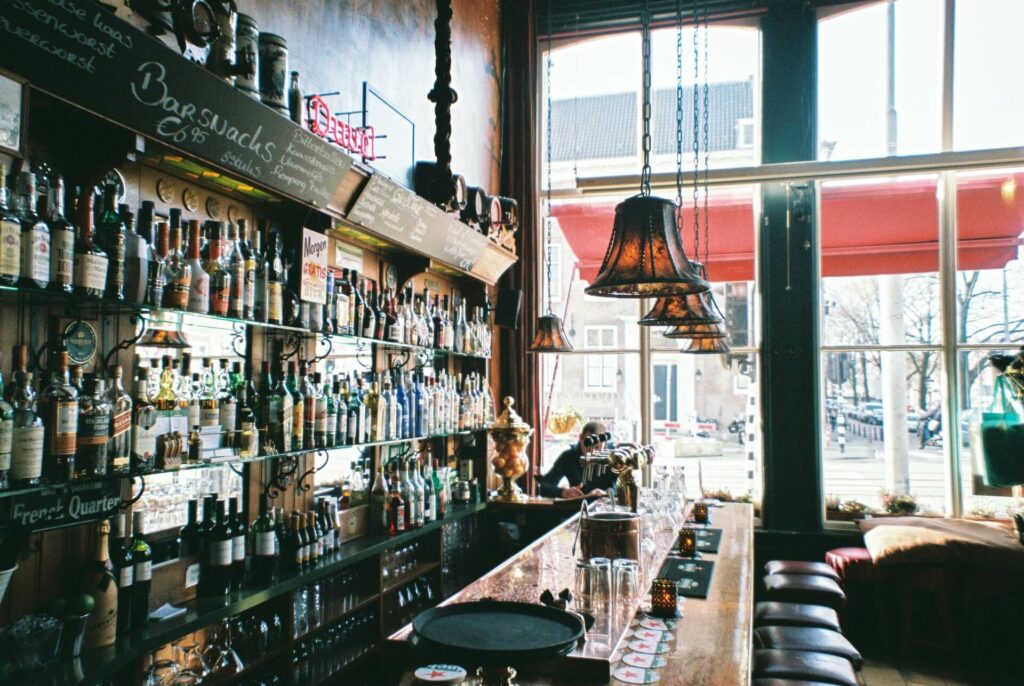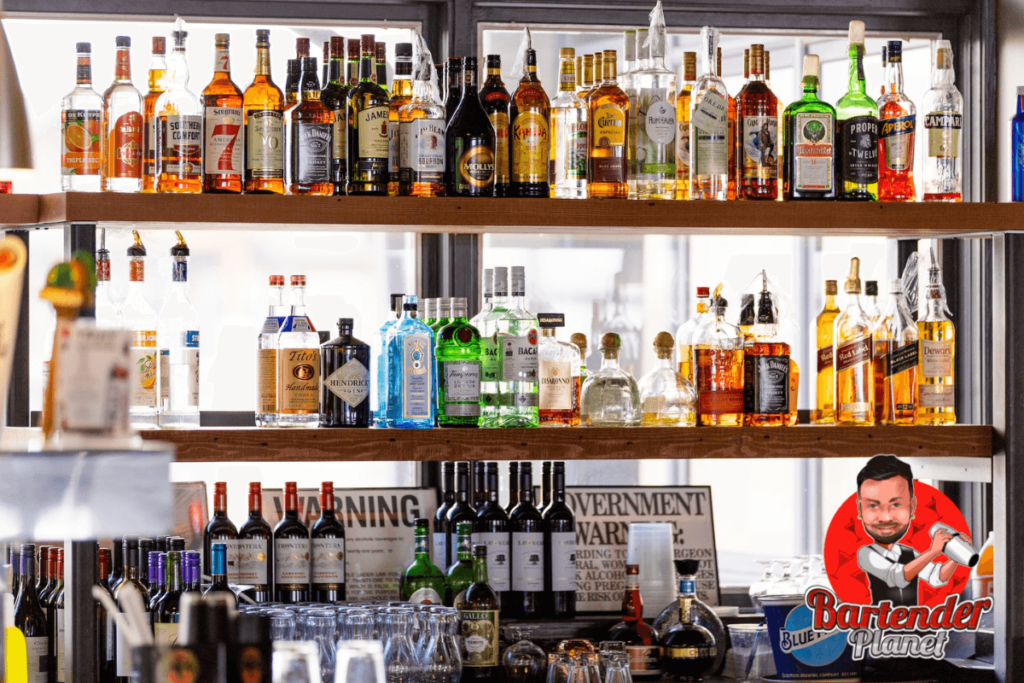As a bartender, I get asked a lot about different types of drinks, especially when it comes to ordering at a bar. One question that often comes up is, “What is a rail drink?”
It’s a simple question, but it’s important to know what it means if you’re planning on ordering a drink at a bar, especially if you’re on a budget.
In this post, we’ll explore the definition of rail drinks, how they differ from their top-shelf counterparts, and why they are a popular choice in bars and restaurants.
Let’s get to it…
What Is A Rail Drink?
A rail drink is a basic drink made with the cheapest liquor available at the bar. It’s called a “rail” because the bottles of liquor are usually kept on a rail or shelf behind the bar.
Rail drinks are typically made with standard ingredients like vodka, gin, rum, tequila, and whiskey. They’re usually mixed with soda or juice, and sometimes with a splash of a more expensive liquor for flavor.
Cheap, cheerful, and perfect for students or those looking to get boozy without spending a fortune.
One thing to keep in mind is that the quality of the liquor used in a rail drink can vary widely depending on the bar. Some bars use decent quality liquor for their rails, while others use the cheapest stuff available.
At its core, a rail drink refers to a type of alcoholic beverage made with lower-cost liquors that are typically stored within easy reach of the bartender, often on the “rail” or “well” – a physical space that is the namesake of these drinks.
These are contrasted with “top-shelf” liquors, which are more expensive and usually reserved for more discerning customers or specific drink requests.
What Is Considered A Rail Drink?
These are the drinks that you will find on every bar menu, and they are usually priced lower than other, more premium drinks.
The exact definition of a rail drink can vary depending on the bar, but generally, they are made with the following types of liquor:
- Vodka
- Gin
- Rum
- Tequila
- Whiskey
Rail drinks are usually mixed with a non-alcoholic beverage, such as soda or juice, to create a cocktail. Some common rail drinks include a vodka soda, gin and tonic, rum and coke, tequila sunrise, and whiskey sour.
But contrary to what you might expect, just because a drink is made with rail liquor doesn’t mean it’s a low-quality drink.
Many bartenders take pride in making delicious cocktails with standard ingredients, and some customers even prefer the taste of rail drinks over more expensive options.
Nothing quite like a great-tasting drink that doesn’t cost an arm and a leg.
So if you’re looking for an affordable drink option at a bar, a rail drink is a great choice. They may not have the same prestige as premium drinks, but they’re still a great choice.
How Much Alcohol Is In A Rail Drink?
The answer to this is not straightforward because the amount of alcohol in a rail drink depends on several factors, such as the type of liquor, the size of the drink, and the establishment’s pour policy.
In general, a rail drink contains between 1 and 1.5 ounces of liquor. But, some bars may pour slightly less or more than this amount.

Keep in mind that rail drinks are typically made with lower-shelf liquors, which have a lower alcohol content than premium brands.
To give you an idea, here’s a table with the average alcohol content of some common rail liquors:
| Liquor Type | Alcohol Content |
| Vodka | 40% ABV (80 proof) |
| Gin | 40% ABV (80 proof) |
| Rum | 40% ABV (80 proof) |
| Tequila | 40% ABV (80 proof) |
| Whiskey | 40% ABV (80 proof) |
Keep in mind that this table represents the average alcohol content of these liquors. Some brands may have a higher or lower alcohol percentage, which can affect the amount of alcohol in your drink.
It’s also worth noting that the mixer used in your drink can dilute the alcohol content. For example, a vodka soda will have a lower alcohol content than a vodka shot.
Ice also plays a role in affecting the amount of alcohol you consume. The more ice, the more diluted you’re drink will become.
How to Order a Rail Drink
When it comes to ordering a rail drink, there are a few things to keep in mind to make sure you get exactly what you want.
Here are some tips to help you order:
- Before you even approach the bartender, it’s important to know what you want to order. Take a look at the menu or think about what you’re in the mood for. If you’re not sure, don’t be afraid to ask the bartender for recommendations.
- When ordering a rail drink, it’s important to be specific about what you want. For example, if you want a vodka soda, make sure to specify the type of vodka you want. If you don’t specify, the bartender will likely use the well vodka, which may not be what you want.
- If you’re not familiar with the terminology, it can be helpful to brush up on your bar lingo. For example, a “neat” drink means no ice, while a “rocks” drink means with ice. Knowing the lingo will help you communicate your order more effectively.
- Remember to be polite when ordering your drink. Bartenders are busy and dealing with a lot of customers, so being polite and respectful will go a long way. Say “please” and “thank you” and be patient if the bartender is busy.
By following these tips, you’ll be able to order a rail drink like a pro and get exactly what you want.
Frequently Asked Questions
What are some examples of rail drinks?
Some examples of rail drinks are gin and tonic, rum and coke, vodka cranberry, and whiskey sour.
Rail drinks are typically made with the house or well liquor, which is the cheapest option available at a bar.
What is the difference between a well drink and a rail drink?
A well drink is any drink made with the cheapest liquor available at a bar. A rail drink is a specific type of well drink that is made with the house or well liquor.
The term “rail” refers to the metal bar or railing where bottles of liquor are stored behind the bar.
Rail drinks are usually cheaper than other drinks because they are made with lower-quality booze.
Final Thoughts
To wrap up, rail drinks are essentially about simplicity and affordability.
They’re the everyday spirits kept within easy reach of bartenders, used in a wide range of common mixed drinks.
While they might not have the prestige of top-shelf liquors, rail drinks are a practical choice for casual outings, happy hours, and anyone looking to enjoy a classic cocktail without a hefty price tag.
So next time you’re at a bar and you opt for a rail drink, know that you’re choosing a staple of the cocktail world – straightforward, reliable, and often just what you need for a good night out.


